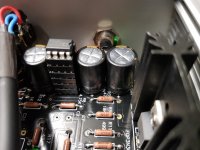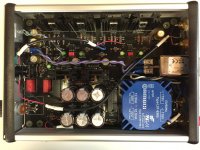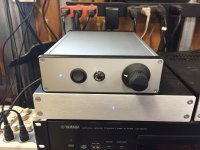Labjr, the airspeed choosen for this work, is it in the low or higher speed range?
It varies by the job and the nozzle I'm using but I'm impatient so usually on the higher side. I have a relatively inexpensive hot air station. I wouldn't mind having a better one.
those sinks looks scary close to the top lid when the outputs are not electrically isolated from the sinks.
those sinks looks scary close to the top lid when the outputs are not electrically isolated from the sinks.
I used everything in the BOM including the listed chassis and sinks. There is a few mil clearance between the top cover and the top of the sinks so they dont touch I did check that when doing the initial build.
Whammy build
Thought I would share my Whammy build. I have built more than a half dozen projects in the DIY store enclosures so I thought I would give the original spec Hammond enclosure a try. Since I wanted a filtered input socket as well as output jacks, layout was tight on the rear panel. I ended up with the right RCA output jack a bit close to the socket.
I really wanted the front panel volume control to be centered vertically, so I chose a 50K audio ALPS RK16 (physically mid-sized between the RK09 and the original spec RK27) and added some leads to get it off the PCB. The shaft damping on the RK16 is not quite as smooth and viscous as the RK27 or even the RK09 but still acceptable. An RK09 with a 99 cent EBay PC adapter board probably would fit.
Add in a front panel power switch, LED and HP jack and the front panel layout pretty much dictates itself. I find the front panel a bit thin. It flexes when removing the headphone plug. The only other mods to the standard build with LED voltage reg control were the Wurth input caps (1/3 the cost of the Vishay caps). I bought both the RC4580 and the LM833 input opamps and have only listened to the RC4580 so far.
My two other HP amps are Pete Millett's NuHybrid and Mark Johnson's T2, both of which have SMPS regulated supplies. All 3 sound different. Not earth shaking but with discernible differences.
Wayne's amp is the most well behaved circuit of the 3. Dead quiet, no turn on or turn off noises, gobs of gain. If there are any drawbacks for me, it is that the bass seems a bit soft compared to the other two, perhaps that is a characteristic of the power supply, maybe the opamp.
The other thing is that the Whammy sound character is pretty obviously driven by the choice of the front end opamp. Mark's T2 beats the Whammy in that respect in that the T2 really doesn't have much of a front end. Also, not enough gain to adequately drive low sensitivity planar magnetic headphones.
So, my initial response is, the Whammy is very quiet, has good gain, is very detailed and would make a good studio monitoring headphone amp but it is not as exciting as either the NuHybrid or even the T2. The NuHybrid ended up the most costly of the 3 because I found I prefer listening to the source in its original polarity, which required some expensive Jensen input transformers, reversed to compensate for the triode circuit inversion inherent in the design.
For a first time builder, I would recommend Mark's T2. Easier to build, less expensive, and more fun to listen to, as long as you don't need a ton of gain.
Thought I would share my Whammy build. I have built more than a half dozen projects in the DIY store enclosures so I thought I would give the original spec Hammond enclosure a try. Since I wanted a filtered input socket as well as output jacks, layout was tight on the rear panel. I ended up with the right RCA output jack a bit close to the socket.
I really wanted the front panel volume control to be centered vertically, so I chose a 50K audio ALPS RK16 (physically mid-sized between the RK09 and the original spec RK27) and added some leads to get it off the PCB. The shaft damping on the RK16 is not quite as smooth and viscous as the RK27 or even the RK09 but still acceptable. An RK09 with a 99 cent EBay PC adapter board probably would fit.
Add in a front panel power switch, LED and HP jack and the front panel layout pretty much dictates itself. I find the front panel a bit thin. It flexes when removing the headphone plug. The only other mods to the standard build with LED voltage reg control were the Wurth input caps (1/3 the cost of the Vishay caps). I bought both the RC4580 and the LM833 input opamps and have only listened to the RC4580 so far.
My two other HP amps are Pete Millett's NuHybrid and Mark Johnson's T2, both of which have SMPS regulated supplies. All 3 sound different. Not earth shaking but with discernible differences.
Wayne's amp is the most well behaved circuit of the 3. Dead quiet, no turn on or turn off noises, gobs of gain. If there are any drawbacks for me, it is that the bass seems a bit soft compared to the other two, perhaps that is a characteristic of the power supply, maybe the opamp.
The other thing is that the Whammy sound character is pretty obviously driven by the choice of the front end opamp. Mark's T2 beats the Whammy in that respect in that the T2 really doesn't have much of a front end. Also, not enough gain to adequately drive low sensitivity planar magnetic headphones.
So, my initial response is, the Whammy is very quiet, has good gain, is very detailed and would make a good studio monitoring headphone amp but it is not as exciting as either the NuHybrid or even the T2. The NuHybrid ended up the most costly of the 3 because I found I prefer listening to the source in its original polarity, which required some expensive Jensen input transformers, reversed to compensate for the triode circuit inversion inherent in the design.
For a first time builder, I would recommend Mark's T2. Easier to build, less expensive, and more fun to listen to, as long as you don't need a ton of gain.
Attachments
Last edited:
those sinks looks scary close to the top lid when the outputs are not electrically isolated from the sinks.
I recommend the use of die-cut mica insulator pads with thermal paste on both sides. In my amp, I can flex the top plate enough to touch the sinks!
For the sub-2-watt applications inside WHAMMY, Bergquist Sil-Pad insulators are perfectly fine. They're cheap, they speed up assembly, and they don't create a sticky goopy mess.
https://www.digikey.com/products/en?keywords=SPK4-0.006-00-58
SPK4-0.006-00-58 Bergquist Company | Mouser
https://www.digikey.com/products/en?keywords=SPK4-0.006-00-58
SPK4-0.006-00-58 Bergquist Company | Mouser
In my amp, I can flex the top plate enough to touch the sinks!
That's what i was thinking. So insulation pads and insulating washer is a must.
I've got 70mm chassis so i don't have this problem.
That's what i was thinking. So insulation pads and insulating washer is a must.
I've got 70mm chassis so i don't have this problem.
This is exactly why I went ahead and isolated mine. The clearance was so tight that I got worried enough that it exceeded my worry about the extra heat 🙂 Another solution would be to strategically kapton tape the top lid to prevent shorting, even if it does touch.
Last edited:
Has anyone tried a Burson V5i op amp in the Whammy with success? I have read some have had issues.
Whammy build: followup
There must be some truth to the "break in" period talked about by many builders. Maybe the electrolytics need time to "form" especially since this build uses Nichicon "green" bi-polars in the signal path.
Anyway, it turns out the "softness" in the bass I first heard appears to be a limitation of some of my headphones. I think they are not quite handling the extended low bass of this amplifier. My original perception of overly clinical sound character in the high end has changed. Still the same amount of detail, which is exceptional, but smoother now. Could just be my brain needed a "break in" period.
I'll have to comb through this forum and look for everyone's favorite opamps. It feels like it may be time to start rolling.
There must be some truth to the "break in" period talked about by many builders. Maybe the electrolytics need time to "form" especially since this build uses Nichicon "green" bi-polars in the signal path.
Anyway, it turns out the "softness" in the bass I first heard appears to be a limitation of some of my headphones. I think they are not quite handling the extended low bass of this amplifier. My original perception of overly clinical sound character in the high end has changed. Still the same amount of detail, which is exceptional, but smoother now. Could just be my brain needed a "break in" period.
I'll have to comb through this forum and look for everyone's favorite opamps. It feels like it may be time to start rolling.
If you have the bravery / chutzpah to assemble an SMD-to-DIP8 adapter card, I think you'll LOVE the OPA1612 dual opamp.
https://www.amazon.com/Uxcell-a14123100ux0003-TSSOP8-Adapter-Converter/dp/B015E4AYU2/
https://www.amazon.com/Adapter-Converter-Double-0-65mm-1-27mm/dp/B01BAFFXX2
SparkFun SOIC to DIP Adapter - 8-Pin - BOB-13655 - SparkFun Electronics
SMD Adapters
https://www.amazon.com/Icstation-SMD-DIP-Adapter-Board/dp/B01KC3M0K2
https://www.amazon.com/McIgIcM-30pcs-Board-Adapter-Converter/dp/B074XNV6L1
I also think you'll like the AD746
https://www.amazon.com/Uxcell-a14123100ux0003-TSSOP8-Adapter-Converter/dp/B015E4AYU2/
https://www.amazon.com/Adapter-Converter-Double-0-65mm-1-27mm/dp/B01BAFFXX2
SparkFun SOIC to DIP Adapter - 8-Pin - BOB-13655 - SparkFun Electronics
SMD Adapters
https://www.amazon.com/Icstation-SMD-DIP-Adapter-Board/dp/B01KC3M0K2
https://www.amazon.com/McIgIcM-30pcs-Board-Adapter-Converter/dp/B074XNV6L1
I also think you'll like the AD746
I read an article on circuit basics site:
A Complete Guide to Design and Build a Hi-Fi LM3886 Amplifier - Circuit Basics
It is about decoupling caps for op amp power rails:
“The large decoupling capacitors provide a lasting source of reserve current when the low frequency output of the amplifier is high. Larger values will improve the bass response. Typical values are between 470 µF and 2200 µF.”
Is it true?
I have some 1000uF caps sitting around.
Maybe I should do a quick test.
A Complete Guide to Design and Build a Hi-Fi LM3886 Amplifier - Circuit Basics
It is about decoupling caps for op amp power rails:
“The large decoupling capacitors provide a lasting source of reserve current when the low frequency output of the amplifier is high. Larger values will improve the bass response. Typical values are between 470 µF and 2200 µF.”
Is it true?
I have some 1000uF caps sitting around.
Maybe I should do a quick test.
I read an article on circuit basics site:
A Complete Guide to Design and Build a Hi-Fi LM3886 Amplifier - Circuit Basics
It is about decoupling caps for op amp power rails:
“The large decoupling capacitors provide a lasting source of reserve current when the low frequency output of the amplifier is high. Larger values will improve the bass response. Typical values are between 470 µF and 2200 µF.”
Is it true?
I have some 1000uF caps sitting around.
Maybe I should do a quick test.
LM3886 is an audio power amplifier IC, not an opamp operated at line level.
I'd like to try the OPA1612 in the SOIC-8 package(with a DIP adaptor board) and see that Mouser has three versions available.
I'm wondering of the three,which is most suitable for the Whammy?
opa1612 Texas Instruments SOIC-8 Audio Amplifiers | Mouser Canada
I'm wondering of the three,which is most suitable for the Whammy?
opa1612 Texas Instruments SOIC-8 Audio Amplifiers | Mouser Canada
I'd like to try the OPA1612 in the SOIC-8 package(with a DIP adaptor board) and see that Mouser has three versions available.
I'm wondering of the three,which is most suitable for the Whammy?
Hi, I can't see any difference, they should be the same, it's the conditioning which differs (reel or tube). You should buy the AID version I believe.
- dan
Oh I see. Thank you for the explanation.
What explanation did you get? 😉
Jan
What explanation did you get? 😉
Jan
Post1514 explained the large decoupling caps are for power amp, not for preamp.
- Home
- Amplifiers
- Pass Labs
- "WHAMMY" Pass DIY headphone amp guide



